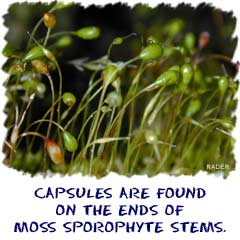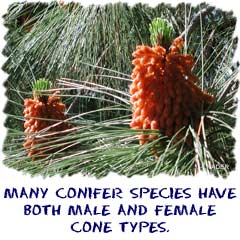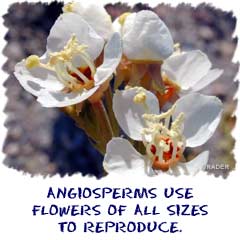
Plant Reproduction - They'll Make More
If you are an organism, you will need to reproduce. Otherwise, there will be no more of your species and the species will die off. You may have heard of endangered animals. There are also endangered plants. These endangered species have very few individuals left and scientists/naturalists are working together to make sure the species don't become extinct. We talked a little about reproduction when we discussed meiosis in the cells tutorials. Reproduction is one of two things.
We talked a little about reproduction when we discussed meiosis in the cells tutorials. Reproduction is one of two things.
(1) One cell can split into two, giving you two identical cells. That type is asexual reproduction.
(2) The second type is when two cells, each with half of the DNA needed, combine and create a living cell. That type is sexual reproduction.
When plants hit a point in evolution, the second is the one that occurs more often.
Making More Mosses
Sporophytes are the reproductive structures you will find in mosses. They are actually a phase of the moss life cycle that feeds off the green parent plant (the gametophyte). The sporophyte is a stalk that grows after the haploid sperm of one moss plant is able to mix with the haploid egg of a female moss plant. The resulting diploid cell grows into the sporophyte stalk. When ready, spores stored in the sporophyte are released and they grow into new moss plants.
Conifers and Their Cones
While there are male and female mosses, conifers produce two types of cones on the same tree. One of the cone types gives off pollen (the staminate cone). The other type of cone catches the pollen if the wind is moving in the right direction. Better yet, the wind blows the pollen to another conifer of the same species, and a cone (called the ovulate cone) catches the pollen. Again, the pollen and megaspore (receiving haploid cell) are haploid and combine to form a diploid cell. That diploid cell grows into a zygote (baby conifer) that eventually lives in a seed.Flowers and Pollen
 The most advanced of the plants have their own way of sexually reproducing. It is a very fancy and very complex process. Plants that rely on flowers for reproduction are also very dependent on outside help such as insects and animals. While conifers have the two structures on one tree, flowering plants went one step further and put the devices that make and receive pollen in the same structure.
The most advanced of the plants have their own way of sexually reproducing. It is a very fancy and very complex process. Plants that rely on flowers for reproduction are also very dependent on outside help such as insects and animals. While conifers have the two structures on one tree, flowering plants went one step further and put the devices that make and receive pollen in the same structure.
How does that help? A bee might go to one flower and get a little pollen on its back. If it goes to another flower of the same species, that pollen can land on the stigma. From that point, one haploid male nucleus combines with a female nucleus and the other haploid male nucleus combines with a polar nucleus. If successful, an embryo and seed/fruit develop respectively.
Related Video...
Working to Increase Pollinators (USDA Video)
Encyclopedia.com (Asexual Reproduction):
http://www.encyclopedia.com/topic/Plant_asexual_reproduction.aspx
Wikipedia (Plant Reproduction):
http://en.wikipedia.org/wiki/Plant_reproduction
Wikipedia (Flowers):
http://en.wikipedia.org/wiki/Flower
Encyclopædia Britannica (Flowers):
http://www.britannica.com/EBchecked/topic/211029/flower



